In the beginning, the history of Black lesbian fiction was fraught with questions of representation: who is the Black lesbian? How is the Black lesbian depicted in American culture?
2024 marks the 50th anniversary of the first publication of a Black lesbian as a main character. Noting the first time a black lesbian was a protagonist in the peak of the 1970s also recalls the internal community conflict during that time: the time of Black civil rights, Black nationalism, and Black Power – all of which demanded that we be Black first, discouraging mention of lesbian identity.
And yet, a brave librarian, journalist, novelist, and scholar, Ann Allen Shockley at the age of 47 authored, Loving Her, the absolute first Black lesbian novel written, ever. For the first time in history, due to Shockley’s vision, centering a Black lesbian perspective was a distinct possibility. Whereas one year prior, in 1973, the publication of Toni Morrison’s, Sula, nodded to the depth of Black female friendship, without a claim to desire, arguably the basic characteristic of lesbian content, even if only in subtext, Shockley introduced the literary landscape to a new protagonist: the black lesbian.
2014 Edition by Open Road Media edition with free previewOpen Road Media
By the 1980s there were more depictions of Black lesbian protagonists. The Women of Brewster Place by Gloria Naylor was published in 1982, which had characters Theresa and Lorraine that offered strong representation of Black lesbians and the challenges that they face within larger Black communities. Alice Walker’s The Color Purple and Audre Lorde’s ZAMI: A New Spelling of My Name, made 1982 an important year for the representation of Black lesbian characters.
Despite negative reviews and alternative images, Shockley’s work was expanded to a translated German edition, Loving Her roman, published in 1982 (with two white rose-cheeked girls on the cover) and then further expanded in the US with a second run in 1984 by…
Read the full article here

Leave a Reply